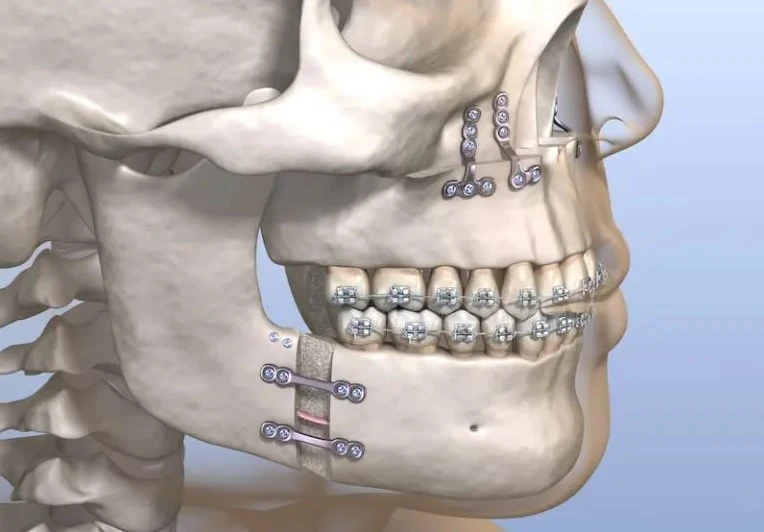Journal
Double Corrective Jaw Surgery in Korea
2024-03-12
Facial Contouring

Double Corrective Jaw Surgery, also known as two-jaw surgery or orthognathic surgery, is a specialized procedure that addresses issues related to the alignment of the upper and lower jaws. In recent years, South Korea has gained recognition as a leading destination for individuals seeking this transformative surgery. In this article, we delve into the details of double jaw surgery, its corrective purposes, expectations, concerns, preparation, and the recovery process.
What is Double Jaw Surgery?
Double jaw surgery, or two jaw surgery, involves the surgical repositioning of both the upper and lower jaws to correct misalignments, irregularities, and functional issues. This procedure is often recommended for individuals with severe underbites, overbites, crossbites, or asymmetry in their jaw structure. The goal is to enhance facial aesthetics, improve bite functionality, and address related health concerns.
Process of Two-Jaw Surgery

- Hyper-precise pre-surgery test is performed 1 week before surgery
- During surgery, the upper jaw is corrected and moved to an ideal position
- The lower jaw is corrected, moved to an ideal position, and aligned with the upper jaw
- The newly designed upper and lower jaw are securely and firmly fixed with titanium pins
- If necessary, temporary orthodontic elastic bands will be used until further recovery
What Does Double Jaw Surgery Correct?
Double jaw surgery is designed to correct various jaw-related issues, including:
Overbite: When the upper jaw protrudes significantly over the lower jaw.
Underbite: When the lower jaw extends beyond the upper jaw.
Crossbite: When the upper and lower jaws do not align properly, causing some teeth to overlap others.
Facial Asymmetry: Irregularities in the alignment of the facial bones.

Two Jaw Surgery Recovery Period
The recovery period after double jaw surgery can vary from person to person based on factors such as the specific procedures performed, individual healing rates, and overall health. Generally, the recovery process can be divided into several stages:
Immediate Post-operative Period (First Week):
At Hospital: Patients typically spend a few days in the hospital after the surgery for close monitoring.
Pain Management: Pain and discomfort are managed with prescribed medications.
Swelling and Bruising: Swelling and bruising around the face and jaw are common, reaching their peak in the first 48 hours.
Diet: Initially, a liquid or soft food diet is recommended to avoid stressing the jaw.
First Few Weeks:
Follow-Up Appointments: Regular follow-up appointments with the surgical team to monitor progress and address any concerns.
Gradual Return to Normal Activities: Patients gradually resume normal daily activities, avoiding strenuous exercise and activities that could impact the jaw.
Swelling Reduction: Swelling begins to subside, but some residual swelling may persist for several weeks.
Weeks 2-6:
Soft Diet Continuation: While some patients may transition to a soft-solid diet, others may still prefer liquid or pureed foods.
Speech and Mobility Improvement: Patients may experience improvements in speech and jaw mobility.
Orthodontic Adjustments: If braces were used as part of the treatment, orthodontic adjustments may be made during this period.
Weeks 6-12:
Orthodontic Adjustments: Ongoing orthodontic adjustments to fine-tune the bite and alignment.
Residual Swelling Reduction: Continued reduction in facial swelling, though complete resolution may take several months.
Return to Regular Diet: Most patients can gradually return to a regular diet, depending on individual healing.
Months 3-6:
Final Orthodontic Adjustments: Final orthodontic adjustments to complete the alignment process.
Residual Effects: Some residual effects like numbness or stiffness may persist but usually improve over time.
Normal Activities: Patients can generally resume normal activities, including more vigorous exercise.
Long-Term Recovery (6 Months Onward):
Final Results: Facial appearance and jaw function continue to improve, and the final results become more apparent.
Follow-Up Appointments: Periodic follow-up appointments to monitor long-term outcomes.
Orthodontic Care: Ongoing orthodontic care may be required for some time to maintain the results.
It's important to note that individual experiences may vary, and the above timeline is a general guideline. Strict adherence to post-operative care instructions and regular follow-ups with the surgical and orthodontic teams are crucial for a successful recovery after two jaw surgery.

Corrective Jaw Surgery Post-Operative Care and Precautions
Post-operative care and precautions are crucial aspects of the recovery process after two-jaw surgery. Adhering to a well-structured care plan helps minimize complications, ensures optimal healing, and enhances the overall success of the procedure. Here are key considerations for post-operative care and precautions following two-jaw surgery:
Pain Management:
Follow the prescribed pain medication schedule to manage discomfort effectively. Use ice packs, for the initial three days after the surgery, to alleviate swelling and reduce pain. Apply them as directed by the surgeon.
Dietary Guidelines:
Initially, maintain a liquid or soft food diet to avoid stressing the jaw. Progress to more solid foods gradually as advised by the surgeon.
Stay hydrated but avoid using straws, as they can exert pressure on the healing jaw.
Oral Hygiene:
Gently rinse your mouth with a prescribed mouthwash or saline solution after meals to keep the surgical sites clean. Follow the recommended oral hygiene routine provided by the surgeon.
Rest and Recovery:
Ensure adequate rest during the initial days post-surgery to facilitate healing. Avoid strenuous physical activities and exercises that may strain the jaw or facial muscles.
Orthodontic Adjustments:
If orthodontic appliances, such as braces, are part of the treatment plan, follow the orthodontist's instructions for adjustments. Attend scheduled orthodontic appointments to fine-tune the bite alignment.
Avoiding Certain Habits:
Refrain from smoking and limit alcohol consumption, as these habits can impede the healing process. Avoid excessive mouth movements, such as wide yawning or chewing gum, to prevent unnecessary stress on the jaw.
Swelling Management:
Continue using ice packs during the initial 3 days to manage swelling. Keep the head elevated, especially during sleep, to minimize swelling around the facial area.
Follow-Up Appointments:
Attend all scheduled follow-up appointments with both the surgeon and orthodontist. Discuss any concerns or changes in symptoms during these appointments.
Medication Compliance:
Take prescribed medications, including antibiotics, as directed by the healthcare provider. Inform the medical team of any allergies or adverse reactions to medications.
Facial Care:
Be gentle when cleaning the face and avoid pressure on the surgical sites.
Gradual Resumption of Activities:
Gradually reintroduce regular activities based on the surgeon's recommendations. Be mindful of limitations and avoid pushing the recovery pace.
Emotional Well-being:
Understand that the recovery process may involve emotional adjustments. Seek support from friends, family, or mental health professionals if needed.
Following these post-operative care and precautionary measures diligently contributes significantly to a successful recovery after two-jaw surgery. Each patient's experience is unique, so it's crucial to tailor these guidelines to individual circumstances and consult with the clinic or Docfinderkorea regularly for personalized advice and support.
Double corrective jaw surgery in Korea offers individuals a chance to address both functional and aesthetic concerns, often leading to life-changing results. With careful preparation, expert surgical care, and diligent post-operative follow-up, patients can achieve a harmonious facial profile and improved oral function, ultimately enhancing their quality of life.
Learn more about two jaw surgery in Korea!
Back


